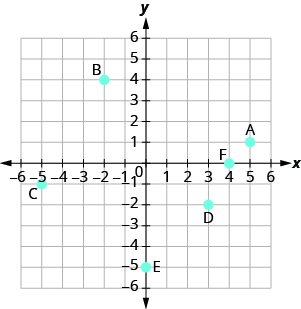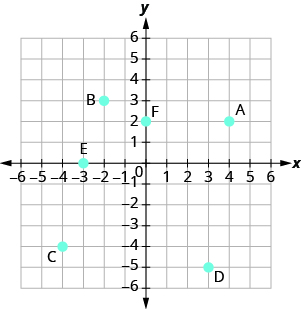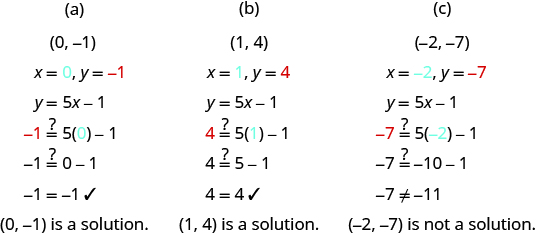| << Chapter < Page | Chapter >> Page > |
Name the ordered pair of each point shown in the rectangular coordinate system.

A: B: C: D: E: F:
Name the ordered pair of each point shown in the rectangular coordinate system.

A: B: C: D: E: F:
Up to now, all the equations you have solved were equations with just one variable. In almost every case, when you solved the equation you got exactly one solution. The process of solving an equation ended with a statement like . (Then, you checked the solution by substituting back into the equation.)
Here’s an example of an equation in one variable, and its one solution.
But equations can have more than one variable. Equations with two variables may be of the form . Equations of this form are called linear equations in two variables .
An equation of the form , where and are not both zero, is called a linear equation in two variables .
Notice the word line in linear . Here is an example of a linear equation in two variables, and .

The equation is also a linear equation . But it does not appear to be in the form . We can use the Addition Property of Equality and rewrite it in form.
By rewriting as , we can easily see that it is a linear equation in two variables because it is of the form . When an equation is in the form , we say it is in standard form .
A linear equation is in standard form when it is written .
Most people prefer to have , , and be integers and when writing a linear equation in standard form, although it is not strictly necessary.
Linear equations have infinitely many solutions. For every number that is substituted for there is a corresponding value. This pair of values is a solution to the linear equation and is represented by the ordered pair . When we substitute these values of and into the equation, the result is a true statement, because the value on the left side is equal to the value on the right side.
An ordered pair is a solution of the linear equation , if the equation is a true statement when the x - and y -values of the ordered pair are substituted into the equation.
Determine which ordered pairs are solutions to the equation .
ⓐ ⓑ ⓒ
Substitute the
x - and
y -values from each ordered pair into the equation and determine if the result is a true statement.

Which of the following ordered pairs are solutions to ?
ⓐ ⓑ ⓒ
a, c
Which of the following ordered pairs are solutions to the equation ?
ⓐ ⓑ ⓒ
b, c
Which of the following ordered pairs are solutions to the equation ?
ⓐ ⓑ ⓒ
Substitute the
x - and
y -values from each
ordered pair into the equation and determine if it results in a true statement.


Notification Switch
Would you like to follow the 'Elementary algebra' conversation and receive update notifications?